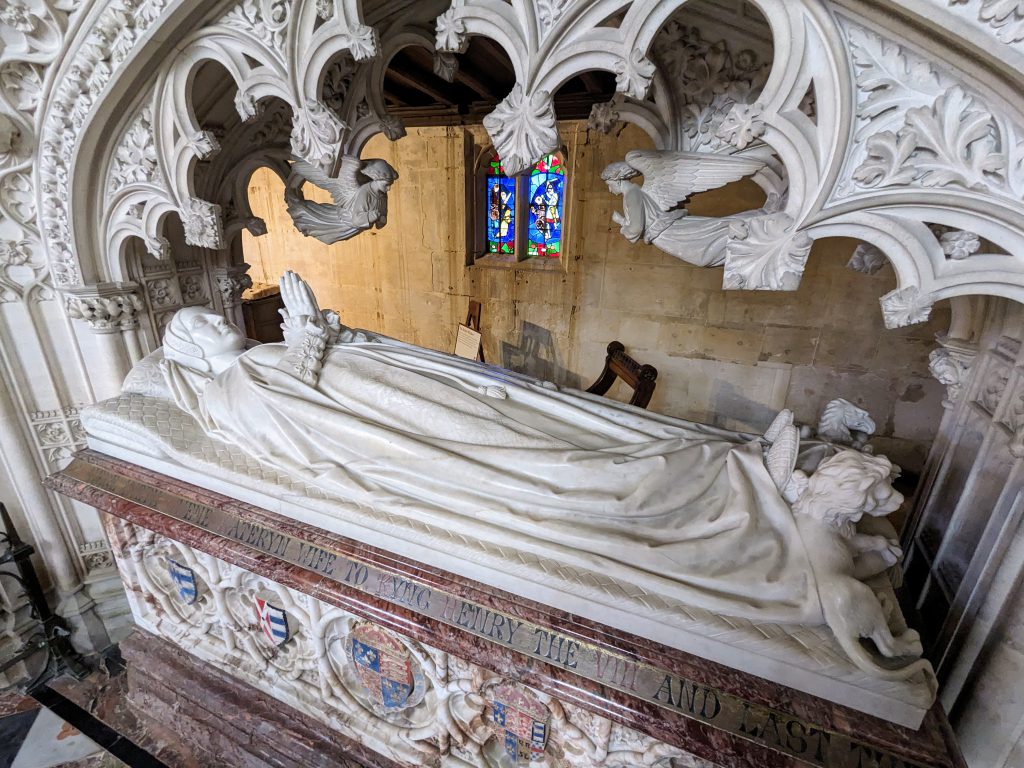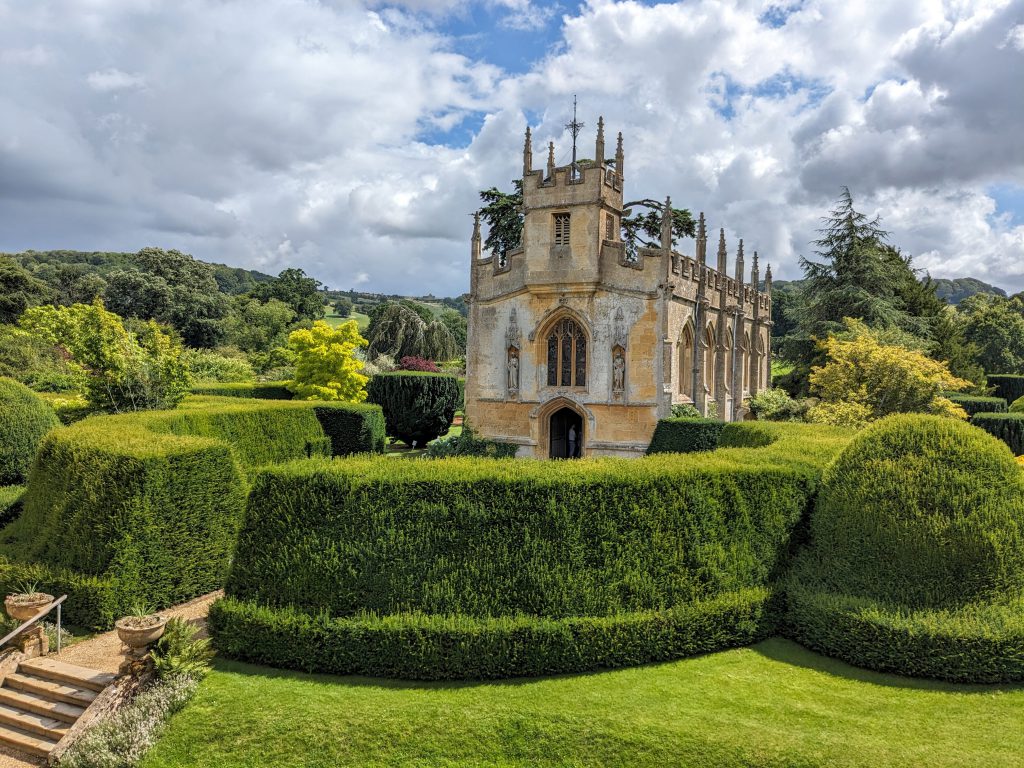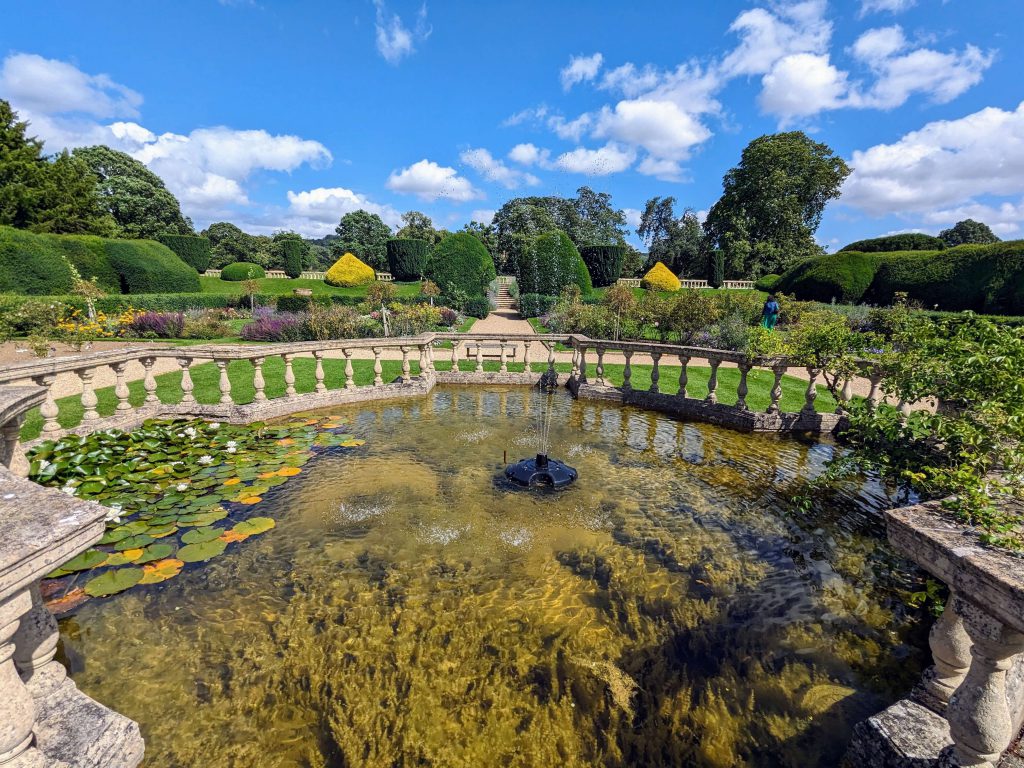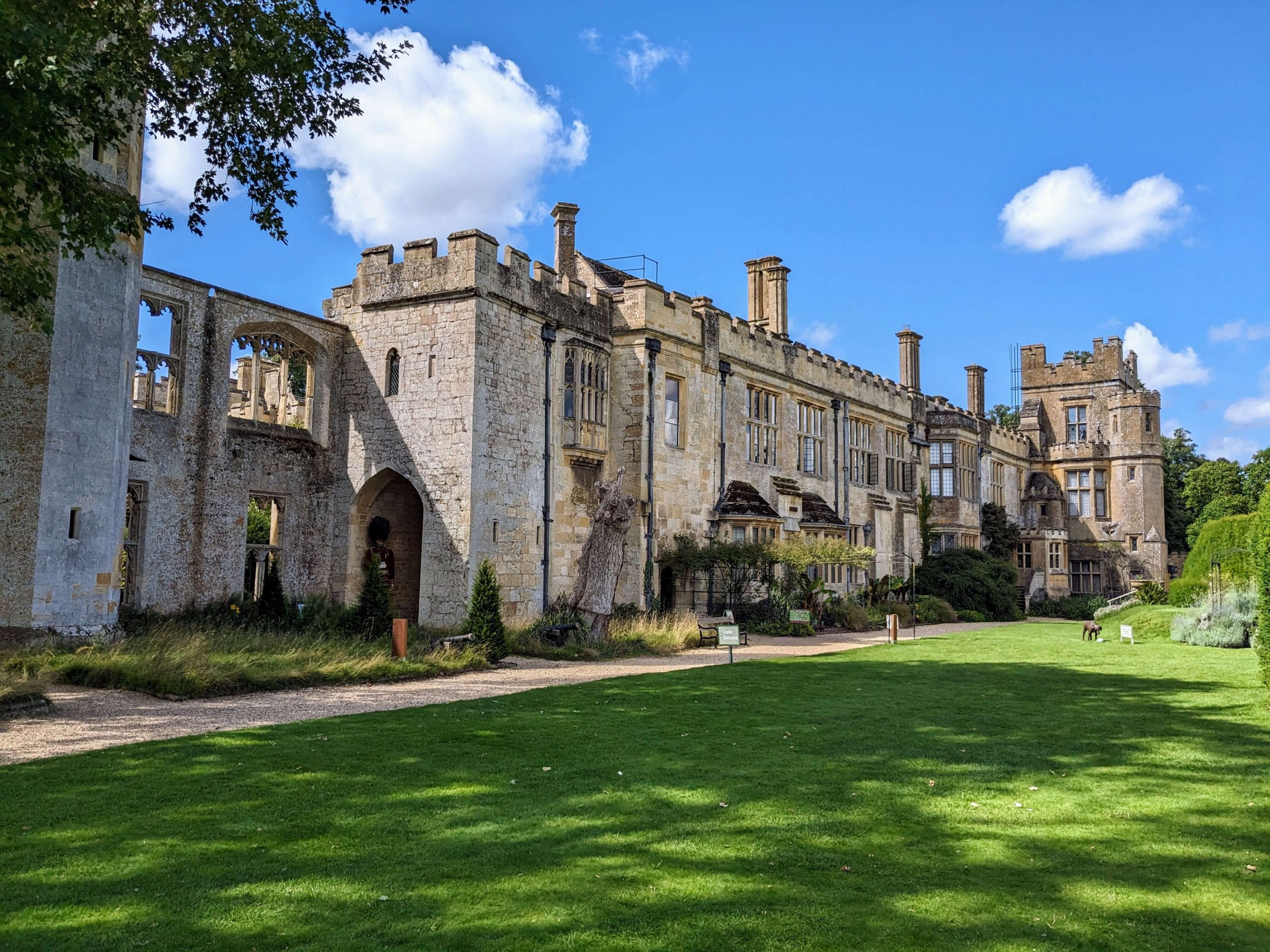The stunning Sudeley Castle is situated near Winchcombe, Gloucestershire. The castle is both beautiful on the interior and exterior, surrounded by a 1200 acre estate that includes ten award winning gardens nestled within the Cotswold hills. The castle is steeped in history with strong royal connections, it has seen many royal guests and Queen Katherine Parr, King Henry VIII’s 6th wife lived, died and was buried at Sudeley. In fact it is the only private castle in England to have a queen buried within its grounds.
| Built | 1443 |
| Condition | Restored |
| Ownership | Dent family |
| Access | Public – Admission Fee |
| Postcode | GL54 5JD |
Click here to watch our video exploring Sudeley Castle and discover the history
Early History
The exact origins of Sudeley are shrouded in mystery, lost in time, we do know that during the reign of King Ethelred ‘The Unready’ (978-1013 1014-16) there was a Royal deer park and Saxon manor house on the site, although nothing remains of the manor. Ethelred passed Sudeley to his daughter, Goda as a wedding gift.
Following the Norman invasion of 1066, King William I stripped many Saxon families of their lands and titles but Goda’s descendant Earl Harold de Sudeley managed to hold onto the estate. This was likely due to Harold’s clever marriage to one of William’s great-nieces, making them distantly related.
The Anarchy
At the time of the civil war known as the Anarchy (1135-1153), the war between Empress Matilda and Stephen of Blois over the succession of the English Crown, Sudeley had been passed down to John de Sudeley. John sided with Matilda causing Stephen to retaliate by attacking and capturing the estate.
By 1165, the Sudeley estate was back in the hands of the Sudeley family, but John’s younger son, William de Tracy caused controversy when he and three other knights murdered Archbishop Thomas Becket in Canterbury Cathedral. This resulted in the Pope excommunicating the knights.
In 1367, the 9th and final Lord de Sudeley, John died whilst fighting for the Black Prince in Spain. Through John’s sister, ownership of Sudeley passed to the Boteler family.


Sudeley Built in Stone
It is believed that in 1443, Ralph Boteler was responsible for building the first stone castle on the present site. Ralph had risen in status and was made a Knight of the Garter and given the title Baron Sudeley from King Henry VI.
Ralph used the spoils he had gained whilst fighting the Hundred Years War in France to construct the castle, in fact it is said that the Portmare Tower is said to be named after a captured French Admiral whose ransom covered the costs for the towers construction. The castle was built on the double courtyard plan surrounded by a moat. The first courtyard served as the functional area for servants and men-at-arms, catering to their needs and operations. Meanwhile, the second courtyard and its accompanying buildings were exclusively reserved for Ralph and his family’s private use. The chapel and Tithe Barn were also constructed during this period.
Seized By The Crown
During the War of The Roses, Boteler sided with the Lancastrian cause and was forced to sell Sudeley Castle in 1369 to Yorkist Edward IV after he was crowned King. King Edward IV granted Sudeley Castle to his brother, Richard, Duke of Gloucester. Richard strategically utilised the castle as a military base in preparation for the significant Battle of Tewkesbury in 1471.
In 1478, Richard exchanged Sudeley Castle for Richmond Castle. However, fate would bring Sudeley back to him when he ascended to the throne in 1483, and he re-inherited the castle as part of his royal holdings. During this time the grand Banqueting Hall with its ornate oriel windows and adjoining state room were built in place of Boteler’s eastern range of the inner court, sadly only ruins remain of this hall.
We might also remember Richard as the uncle who took his two young nephews to the tower of London for the eldest to be crowned. Soon after their arrival the young princes vanished, never to be seen again and Richard was crowned King instead.
At the Battle of Bosworth in 1485, Richard was defeated and killed, bringing an end to the War of Roses and the start of a new era with the first Tudor monarch, Henry VII.


Tudor Era
King Henry VII granted Sudeley Castle to his loyal uncle, Jasper Tudor, who held it until his death in 1495. As Jasper had no heirs the castle then returned to the crown.
During the reign of King Henry VIII he neglected the castle and it began to fall into decline. Henry only visited the castle once, in 1535 with his wife, Anne Boleyn, however it is believed that it was during this stay that he visited Thomas Cromwell at Winchcombe Abbey to plan the Dissolution of the Monasteries.
Following Henry’s death in 1547, the crown and castle passed to his son, King Edward VI. The young Edward granted Sudeley to his ambitious uncle, Sir Thomas Seymour, whom he later appointed Lord High Admiral of England. 1547 was also the year that Seymour secretly married King Henry VIII’s widow, Queen Katherine Parr, however their relationship is said to have begun long before Henry’s death.
Seymour set about refurbishing the castle to ensure that it was ‘fit for a queen’ and in 1548 the newlyweds moved into Sudeley. Katherine was accompanied by an extensive retinue which included Lady Jane Grey (who one day would be Queen herself briefly) and her ladies in-waiting, 120 Yeomen of the Guard and Gentlemen of the Household. By this time, Katherine had unexpectedly become pregnant with her first child at the age of 35. On 30th August 1548, Mary Seymour was born, but Katherine tragically died just a few days later of puerperal fever. Katherine was buried in the Chapel of St Mary at Sudeley, with Lady Jane Grey as the chief mourner. Thomas Seymour did not attend the funeral, he had already left for London, apparently looking for his next bride.
The following year Thomas Seymour was arrested and put on trial for 33 counts against King and Crown. He was executed on March 20, 1549. Sudeley passed to Katherine’s brother, William Parr, the Marquess of Northampton, but he was stripped of his titles and properties after being involved in John Dudley’s failed plot to make Lady Jane Grey Queen, Sudeley was once again seized by the crown. Perhaps the saddest part of all is that it remains a mystery what became of baby Mary Seymour, there is no mention of her after the age of around two and if she did survive she never inherited any of her family’s titles or wealth.


In 1554, Queen Mary elevated John Brydges to Baron Chandos of Sudeley. Prior to this, he had served as the Lieutenant of the Tower of London. As the Lieutenant of the Tower of London, during the early part of Queen Mary’s reign, John Brydges had custody not only of Lady Jane Grey and Thomas Wyatt but also, for a brief period, the Queen’s half-sister, Princess Elizabeth Tudor (later Queen Elizabeth I).
The 2nd Lord Chandos, Edmund, carried out extensive renovations at the castle during the 1560’s and 70’s, almost completely rebuilding the outer courtyard.
Queen Elizabeth I is known to have visited Sudeley Castle on three different occasions. In 1574, Elizabeth visited her old friend, the recently widowed Dorothy Bray, Baroness Chandos, at Sudeley Castle. She stayed there again in 1575 during the Royal Progress, during which Robert Dudley hosted a grand and extravagant party at Kenilworth Castle in a final attempt to persuade Queen Elizabeth to marry him.
Elizabeth’s final and most notable visit was in 1592 during her summer progress to celebrate the anniversary of the defeat of the Armada. The 3rd Baron Chandos went all out to welcome Elizabeth, organising a magnificent three-day celebration in hope of gaining rewards at court. In anticipation of her arrival, Giles took great care to landscape the castle’s grounds, creating a breathtaking setting. Throughout her stay, the Queen was treated to opulent banquets, captivating plays, enchanting dances, and received lavish gifts. The visit is said to have almost bankrupted the family and Elizabeth presented no rewards for the hospitality!
English Civil War
Sudeley Castle continued to thrive under the Chandos family. When the first English Civil War began in 1642, George Brydges, 6th Baron Chandos declared his support for the King rather than Parliament. George marched to join King Charles I at Shrewsbury with 1000 men and £500 of gold plate.
In 1643, Parliamentarian Colonel Massey, along with 500 soldiers and 2 cannons attacked Sudeley Castle. With George away fighting, Sudeley quickly fell and was plundered. The tide quickly changed again, two days later King Charles’s nephew, Rupert, along with 4000 men, successfully captured nearby Cirencester. Once news of this reached Massey he promptly abandoned Sudeley.
Later that same year, King Charles himself set up camp at Sudeley, using it as his operations base for Gloucestershire. The castle was attacked and captured several further times during the Civil War. Most notable is when in 1644, Parliamentarian Sir William Waller ordered a ferocious cannon bombardment of Sudeley. The castle’s garrison withstood the bombardment but they were betrayed by one of their own officers, who granted access to the Parliamentarians.
Following the Parliamentarians victory in the Civil War, parliament ordered Sudeley Castle to be slighted (destroyed) so that it could never again be used for military purposes. Lord Chandos received £1000 compensation for his castle’s destruction, but never returned to it alive. On 13 May 1653, George took part in a duel in which he killed Colonel Henry Compton, the son of Sir Henry Compton. This duel is one of the earliest recorded instances of its kind. After a prolonged period of imprisonment in the Tower of London, George was tried and found guilty of manslaughter on 17 May 1654, he died of smallpox that same year and was laid to rest at Sudeley Castle.


Neglect & Disaster
Sudeley Castle lay neglected for almost 200 years. The estate changed hands on various occasions and was leased to tenants, some of whom helped themselves to the castle’s stone for their own building projects. The castle was even used as an inn at one point, called ‘The Castle Arms’.
In 1782, Katherine Parr’s tomb was rediscovered in Sudeley’s ruined chapel and opened. Those who opened the coffin expected to find bones and were shocked to find her remains complete due to embalming. The coffin was opened and disturbed on numerous further occasions until she was finally laid in her final resting place in the stone vault of the Chandos family.
In 1788, Sudeley Castle was leased to the local gentry Lucas family and King George III visited. The stay very nearly ended in tragedy when George tripped and fell down the staircase of the Octagon Tower. Luckily, the housekeeper, Mrs Cox caught George and broke his fall.
A Second Chance For Sudeley Castle
Just as Sudeley’s fate appeared set for further decay and ruin, brothers John and William Dent, wealthy glove manufacturers purchased the castle and set about on an extensive but sensitive restoration. The brothers chose to leave some of the earliest areas as picturesque ruins. By 1840, work on the Elizabethan ranges of the outer courtyard were complete.
The brothers furnished the restored castle with exquisite Tudor pieces, many acquired at the Strawberry Hill Sale. Restoration at the estate continued which included the chapel and stable block. Neither of the brothers had any heirs so following their passing, their nephew John Croucher Dent inherited Sudeley in 1856. John married Emma Brocklehurst, of the wealthy silk manufacturer family.
The couple continued renovations at the castle and recreated the historic gardens. Emma also funded a project at nearby Winchcombe so that the town had piped water supplies.
During the Second World War, Sudeley Castle was used as a prisoner of war camp for Italians and Germans. It also housed much of the Tate Gallery’s picture collection to protect the artwork from the London Blitz.
In 1949 Sudeley was owned by Mark and Mary Dent-Brocklehurst. Mary inherited and moved the esteemed Walter Morrison fine picture collection to the castle.
Sudeley Castle has continued to be passed down the Dent family line and is still owned by the family today, Due to crippling death duties much land has sadly had to be sold to cover the costs and the estate has reduced in size from 12,000 to 1,200 acres (still a considerable size). The castle and award winning gardens are open seasonally for the public to visit and enjoy.
Click below to explore Sudeley Castle with us

